
by Kate S. Zalzal Friday, January 13, 2017
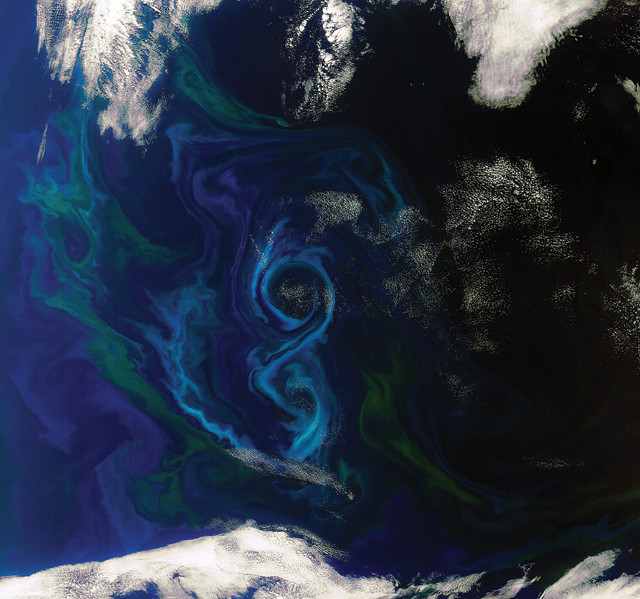
An Envisat image of a phytoplankton bloom in the South Atlantic Ocean east of the Falkland Islands on Dec. 2, 2011. Chlorophyll pigment detected by ocean-color sensors on Earth-observing satellites can help identify species in algal blooms and their toxicity. Credit: ESA.
In May 2015, a seizure-wracked sea lion hauled itself ashore on a beach in southern Washington. Testing confirmed it was suffering from domoic acid poisoning, an illness that causes disorientation, seizures and sometimes death that stems from the consumption of fish or shellfish contaminated by a toxic species of algae called Pseudo-nitzschia. To the south, in warm California waters where localized toxic blooms of Pseudo-nitzschia are a near-annual occurrence, sea lion illnesses caused by exposure to domoic acid are common — however, this was a first in Washington. The sick sea lion was euthanized, but its stranding in Washington alerted coastal communities to the massive algae bloom that was engulfing coastal waters from Santa Barbara, Calif., all the way to British Columbia.
Ecosystems and fishing communities along the U.S. Pacific coast were disrupted for months after the 2015 bloom as the toxins it produced worked their way through the food web. The bloom was unprecedented in its geographic extent and toxicity. Domoic acid levels in Monterey Bay were 10 to 30 times higher than during a normal Pseudo-nitzschia bloom. Hundreds of sea lions died or were euthanized along the West Coast; many more were sickened by domoic acid. Commercial and recreational shellfish and crab fisheries were closed for weeks along nearly the entire coast, with months-long closures in some areas. Health advisories were issued for anchovy and sardine fisheries. California alone requested $138 million in federal disaster aid as a result of closure of the commercial crab fishery; some fisheries remained closed for more than a year.
The 2015 Pacific bloom is just one example of the growing number of severe algal blooms that are occurring in unexpected locations and at unusual times throughout the world’s oceans. As the ocean and atmosphere adjust to a warming climate, toxic algae species are often poised to take advantage of new habitats.
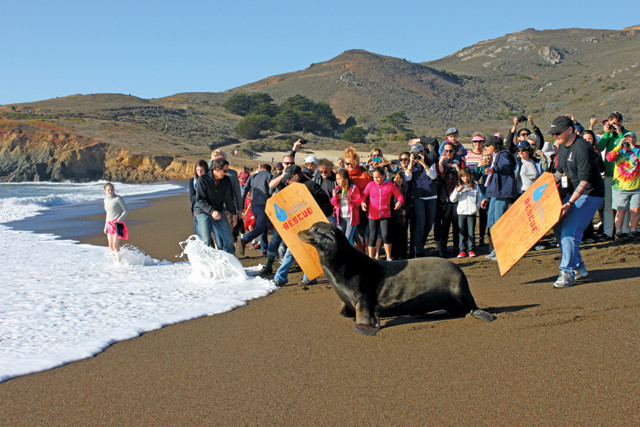
Scoggins was treated for domoic acid toxicity and released back into the ocean at Rodeo Beach on Jan. 3, 2014. Credit: ©The Marine Mammal Center.
In recent years, scientists have been seeking funding to allow for better monitoring and forecasting of harmful algal blooms, as well as further research into how such blooms will respond to climate change and ocean acidification. Researchers are also trying to understand what has made Pseudo-nitzschia and other species so successful and so deadly.
“Algae” is a catch-all term for a wide variety of aquatic organisms that rely on photosynthesis for energy and range in form and size from seaweed and giant kelp down to single-celled microalgae, including cyanobacteria, diatoms and other phytoplankton. When conditions are right, algal cells rapidly reproduce and grow, creating large colonies called blooms in surface waters where light penetrates.
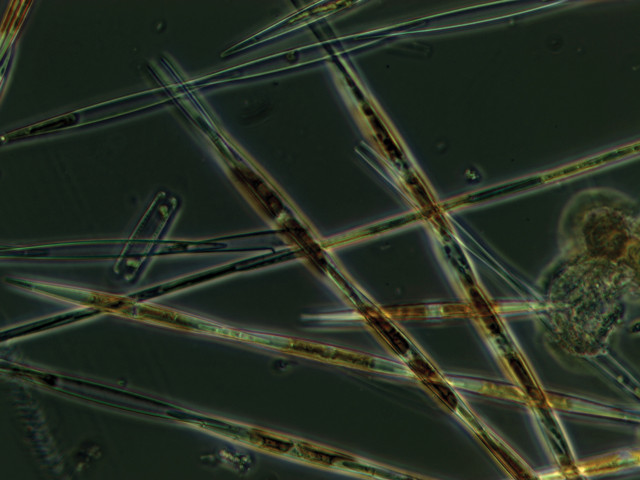
Microscopic images of Pseudo-nitzschia, a diatom that can produce the toxin domoic acid. Credit: Anthony Odell/University of Washington.
Most algae (more than 99 percent) — and most algal blooms — do not produce toxins. Toxic algal blooms become problematic when the algae multiply too quickly, and when they negatively affect people and ecosystems as their toxins are transferred up the food chain. Harmful algal blooms, or HABs, have been observed along every U.S. coast and in coastal zones around the world. They vary widely in size, from covering a few square meters in a pond to the entire U.S. Pacific coastline, and can take many forms. Macroalgal blooms, for example, can choke off native species and lead to reduced water quality. High-density blooms of microalgae can cause oxygen depletion in the water column, resulting in death of marine animals. Spikes and spines on certain diatoms can cause massive fish kills by clogging their gills. A chemical produced by the dinoflagellate Akashiwo sanguinea can damage the waterproof coatings of seabird feathers. And toxins produced by some cyanobacteria, dinoflagellates and diatoms, like Pseudo-nitzschia, can cause debilitating, and even fatal, syndromes in the animals and humans who are exposed to it.
“HAB formation is a process that requires a sequence of perfectly timed factors,” says Vera Trainer, manager of the Marine Biotoxin Program at NOAA’s Northwest Fisheries Science Center in Seattle. Algae growth that reaches bloom proportions involves a complex interplay of factors such as macronutrient and trace metal availability, temperature, salinity, and light, as well as interactions with other organisms such as bacteria and zooplankton grazers that can feed on the algae. Now, scientists are working to better understand the complex environmental drivers of and responses to large-scale HABs, particularly the conditions that lead to highly toxic blooms.
Toxin production in algae is not a straightforward process. “Not all Pseudonitzschia species produce toxins, and the ones that do don’t produce them all the time,” says Stephanie Moore, a visiting scientist at the Northwest Fisheries Science Center. Why some algae produce toxins and, thus, why some blooms are more dangerous than others remains unclear.
Scientists have been particularly interested in studying the disastrous 2015 Pacific HAB event, hoping to apply lessons learned from it to better understand severe HABs in the future. In the 2015 event, scientists think that unusual oceanographic conditions that had been brewing for more than a year were largely to blame.
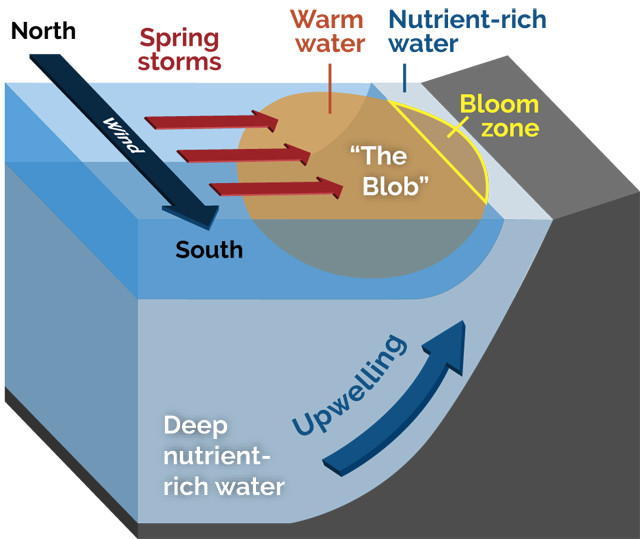
In April 2015, storms blew the warm waters of the Blob close to shore where they mixed with nutrient-rich upwelled water, triggering a massive algal bloom. Credit: K. Cantner, AGI.
Then, in mid-April 2015, the spring transition began as usual and the dominant wind direction switched, blowing southward, driving coastal waters offshore and triggering upwelling of cold, nutrient-rich water into surface waters where sunlight can facilitate photosynthesis.
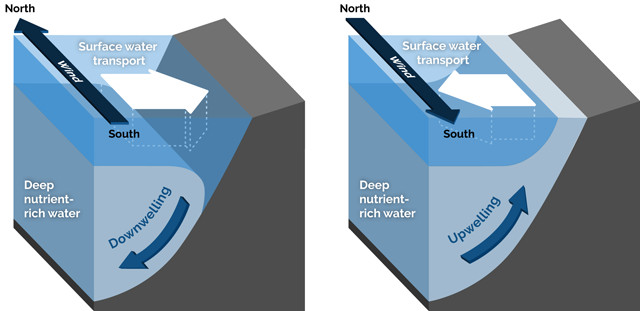
In winter, wind from the south drives surface water toward the shore, pushing surface water down into deep water. Credit: K. Canter, AGI.
The spring transition often triggers blooms as algae take advantage of the newly available nutrients and increased sunlight. Typically, the blooms start near shore and, as they develop and grow, are transported farther offshore as winds and upwelling drive surface waters away from the coast.
But in 2015, a series of spring storms blew the surface waters back toward the coast, bringing the warm waters of El Niño and the Blob, containing Pseudo-nitzschia, into the nutrient-rich upwelling zone and the bloom erupted.
“It all happened extremely quickly, over the course of just a few weeks,” says Ryan McCabe, an oceanographer at the Joint Institute for the Study of the Atmosphere and Ocean at the University of Washington and lead author of a study in Geophysical Research Letters that linked the bloom to the unusual ocean conditions.
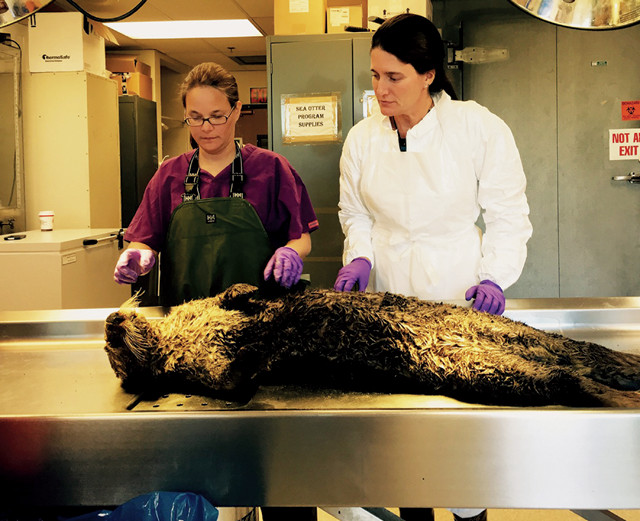
Susan Knowles (left), of the U.S. Geological Survey's Wildlife Health Center, and Kathi Lefebvre (right), of the NOAA Northwest Fisheries Science Center's Wildlife Algal-toxin Research and Response Network for the West Coast (WARRN-West), perform a necropsy of a Northern sea otter at the U.S. Fish and Wildlife Service's Marine Mammal Management Laboratory in Anchorage, Alaska. Samples were taken for algal toxin analysis conducted at WARRN. Credit: Craig Welch.
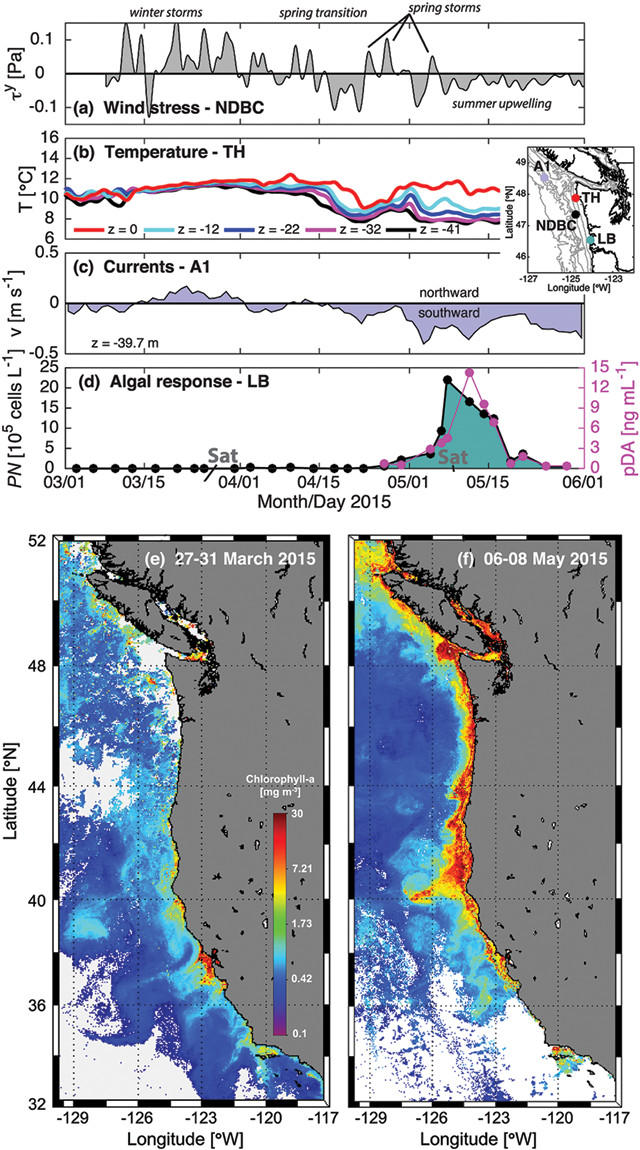
Satellite chlorophyll-a estimates along the U.S. West Coast in March 2015 versus May 2015. The May estimates show a dramatic increase in chlorophyll-a associated with spring upwelling and phytoplankton blooms along the coast. Credit: Ryan McCabe.
Coastal managers immediately began to see elevated domoic acid levels in water and shellfish. “Everybody working along the coast began chiming in: ‘It’s up here in Washington, down here in Oregon, it’s here in California,’” McCabe says. “Our hypothesis early on was that we simply had multiple active hot spots,” where blooms had either developed or concentrated, he says. Blooms usually originate at retentive sites like seasonal eddies and submarine banks where water recirculates.
But on May 21, the sick sea lion washed ashore at Long Beach, Wash. “When I heard about that sea lion and its symptoms, I thought, ‘That’s it, there’s something big happening offshore,’” Trainer says. She was right; a single, particularly toxic species of Pseudo-nitzschia called Pseudo-nitzschia australis had simultaneously bloomed along the coast from central California to southern British Columbia. “They are highly adapted to stressful conditions,” Trainer says. “The Pseudo-nitzschia australis outcompeted other more endemic diatom species that are less toxic.”
Nearly as quickly as it formed, the P. australis bloom decreased along the coasts of Washington and Oregon as newly upwelled water transported more regionally common species from deeper in the water column. By late May, the bloom was almost gone. However, in California, where warmer coastal waters are more typical, pockets of toxic blooms remained throughout 2015 and recurred in 2016.
Despite the bloom’s relatively short life, its impacts quickly propagated up the food chain, resulting in both the highest concentrations of domoic acid ever observed in U.S. seafood and the largest geographic extent of domoic acid in marine mammals ever detected globally. Whales, dolphins, porpoises, sea lions and seals were sickened from southern California to at least northern Washington, and many died. An unusual mortality event in Alaska involving 30 whales at the time of the bloom has suspected links to domoic acid, but the remote location of the event and its unexpected presence so far north precluded sample collection for conclusive diagnosis.
Major commercial and recreational fisheries — including razor clams, Dungeness crab and rock crab — were shuttered up and down the coast, with closures in some areas lasting months or more as the domoic acid outbreak continued to impact benthic organisms long after the P. australis bloom dissipated.
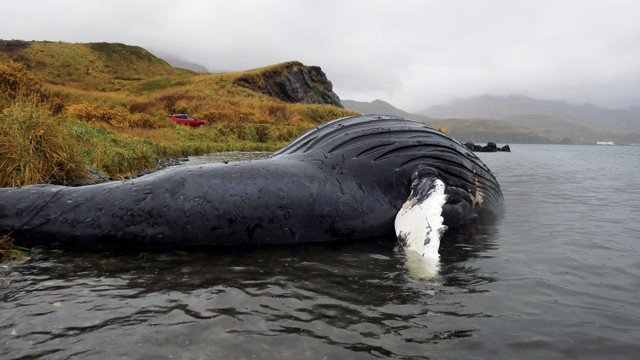
A dead Humpback whale in Dutch Harbor, Alaska. Samples from the animal were taken for algal toxin analysis at NOAA's Wildlife Algal Toxin Research and Response Network. Credit: Kathy Burek-Huntington/Alaska Veterinary and Pathology Services.
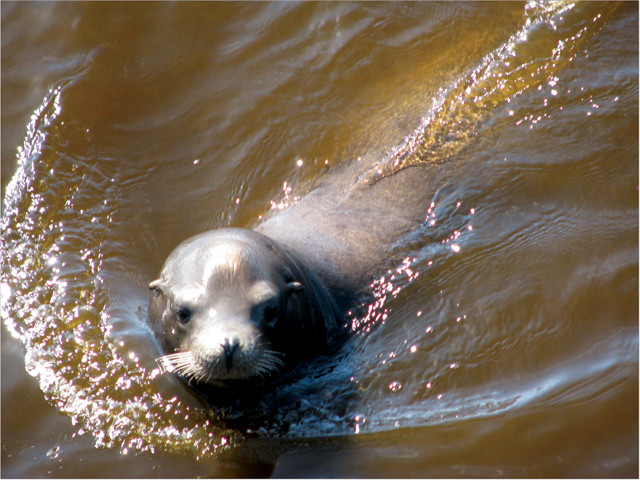
A sea lion swims off the coast of California in waters tinted brown by a dinoflagellate bloom. Credit: Raphael Kudela.
This event was also a wake-up call that these highly toxic blooms may have unexpected impacts, says Raphael Kudela, a phytoplankton ecologist at the University of California, Santa Cruz. In addition to the marine mammals and crabs that were contaminated with domoic acid, scientists also found the toxin in the stomachs and, for the first time, the muscles of fish. It became clear, he says, that “you can get toxins throughout the food web, [the contamination] lasts a lot longer than we thought, and it’s getting into parts of fish that we used to think weren’t a problem.”
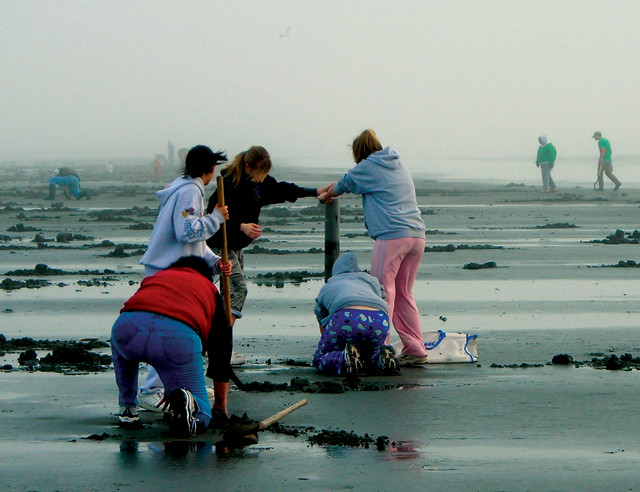
A family digs for shellfish in the Pacific Northwest. Dungeness crab and oysters contribute $72 million annually to local economies; both fisheries were shut down by the massive algal bloom in 2015. Credit: NOAA.
Fortunately, no humans were reported to have become sick that year, despite the extent and toxicity of the event. “Our monitoring and regulatory programs work,” Kudela says. The toxins from HABs “are something that can, so far, be managed.” Whether that will continue to be the case is unknown. “We’d never seen those levels of toxins before, and it’s making us rethink how we manage blooms,” Kudela says. “As the ocean warms up, [these blooms] are going to become more and more of an issue.”
The first recorded toxic event of Pseudo-nitzschia was in 1987 off Prince Edward Island, just north of Nova Scotia, Canada. In 1991, a Pseudo-nitzschia bloom was first observed along the U.S. West Coast, but it wasn’t thought to be harmful to many marine species. Then in 1998, hundreds of sick sea lions became stranded in Monterey Bay, Calif., poisoned by domoic acid. That year, an extremely strong El Niño event, similar to that of 2015, had brought warm, stratified waters to the coast. Since then, Pseudo-nitzschia poisoning with varying degrees of severity has been documented every year in Monterey Bay. But there have been multiyear gaps when no domoic acid events occurred farther north, in Washington and Oregon. The simultaneous domoic acid closures along the entire West Coast were unprecedented. Scientists are trying to determine if the size and severity of the 2015 event was a preview of what we may see in an ocean projected to warm by nearly 2 degrees Celsius by the turn of the century.
To understand how changing climate and ocean conditions might affect HABs, “we have to look at the drivers that govern phytoplankton growth” — chiefly, temperature, light and nutrient availability, Moore says. “We know from laboratory experiments and field measurements that phytoplankton growth rates generally increase with increasing temperature” — at least up to a point.
In 2015, the warm Blob and El Niño waters brought to Oregon, Washington and British Columbia conditions that are more typical of central California where localized P. australis blooms are common. These warm waters sustained the P. australis cells until they could be transported to the coast. Once the algae had access to nutrients, the warm waters allowed them to grow quickly.
But just how warmer ocean temperatures may cause blooms to expand into new locations, occur earlier in the year, or last longer are open questions, Moore says, especially considering that warming is not always uniform. For example, high latitudes are currently experiencing the most warming, a trend that’s projected to continue. Phytoplankton species usually observed in warmer waters recently have caused problems in Alaska, along the Maine coast, in Chilean waters and in the western Pacific — evidence that shifts in HAB location are already underway, Trainer says.
On the other hand, Kudela says, some areas may become too hot for certain phytoplankton to survive. In 2015, for example, exceptionally warm temperatures off the southern California coast pushed Pseudo-nitzschia into areas farther north, he says. “We’re seeing these organisms tracking their preferred temperature as ocean temperatures change around the world.”
A second major factor affecting HABs is nutrient availability, which is driven in part by stratification in the water column. Scientists think that the ocean’s upper 50 meters will become more stratified as air and water temperatures rise and as glacial and snowpack meltwater input into the oceans increases; freshwater and saltwater tend to remain in distinct layers rather than mixing. Changes in the timing of seasonal wind shifts and in wind strength, both of which affect upwelling and water column mixing, may also alter how stratification impacts blooms, McCabe says, especially in the mid- and high latitudes.
“Warm water tends to enhance stratification and make it more difficult to get nutrients up to the surface,” McCabe says, which has major implications for the composition of phytoplankton communities and their potential toxicity. “For example, Pseudo-nitzschia are extremely well poised to take advantage of both of these [conditions],” he says. “If it’s warm, they grow fast; if there are low nutrient levels, they tend to produce more domoic acid, which some studies suggest helps them to take up any nutrients that are there.”
Red tide events, in which ocean waters can take on a red or brown color due to dinoflagellate blooms, may also become more prevalent with a more stratified ocean column, Kudela says. “Dinoflagellates like being in warm surface waters and they are strong swimmers. They can swim down to get the nutrients they need and therefore can outcompete other organisms,” he says.
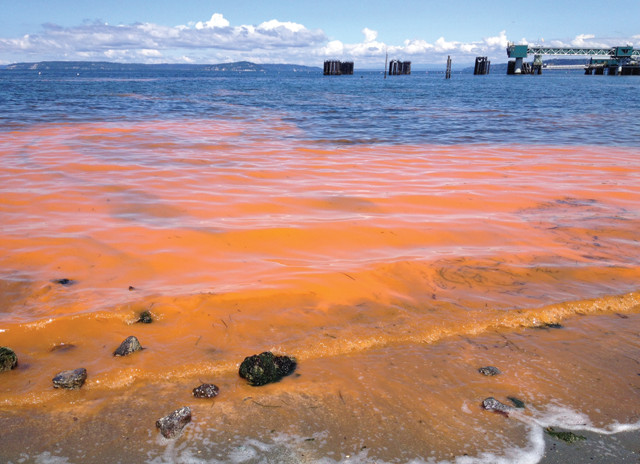
A red tide event along the coast of Edmonds, Wash., in May 2013. Credit: Chuck Woodbury.
Several unexpected and damaging dinoflagellate blooms have occurred off the West Coast in recent years, Kudela says, evidence of how these organisms are responding to oceanographic changes. “We went from not really seeing [red tides] to having a damaging event every few years now. And each of these events has occurred during a warm year.”
In a 2014 review published in Deep Sea Research, Elisa Berdalet Andrés of the Institute of Marine Sciences in Barcelona, Spain, and her colleagues identified multiple HAB species that can flourish in well-stratified systems — Pseudo-nitzschia among them. Other HAB species, meanwhile, may be restrained under intense stratification, depending on local conditions. For example, blooms of a biotoxin-producing dinoflagellate called Alexandrium fundyense occur most years in the Gulf of Maine. However, research led by Dennis McGillicuddy at Woods Hole Oceanographic Institution found that, in 2010, an unusual influx of fresh, warm water led to strong stratification that effectively subdued the bloom.
Yet another factor in the mix is ocean acidification. Surface water pH is projected to decrease by 0.3 to 0.4 units by the end of the century, with upwelling regions most strongly impacted. As waters become more acidic, plankton assemblages are expected to change — but how they will change is unknown. Research shows contradictory responses in growth rates and toxicity in many phytoplankton species, Kudela says. Some cannot survive at lower pHs, but some do better. “By changing pH you change the way phytoplankton work, but we don’t know exactly what that will mean.”
Relationships among cell ecophysiology, toxin production and nutrient supply can vary from bloom event to bloom event and between laboratory studies, complicating our understanding of how changes in stratification and acidification may impact HABs, Kudela says.
Understanding how algae toxicity will be affected as temperatures and nutrient availability change is a critical piece of assessing HAB threats in the future, Moore says. Toxicity is “what is really important in terms of seafood safety and how [climate change] is going to impact marine wildlife and coastal fishing communities,” she says. “You can have the same number of cells, but if they are more toxic, then you’re going to have more of an impact.”
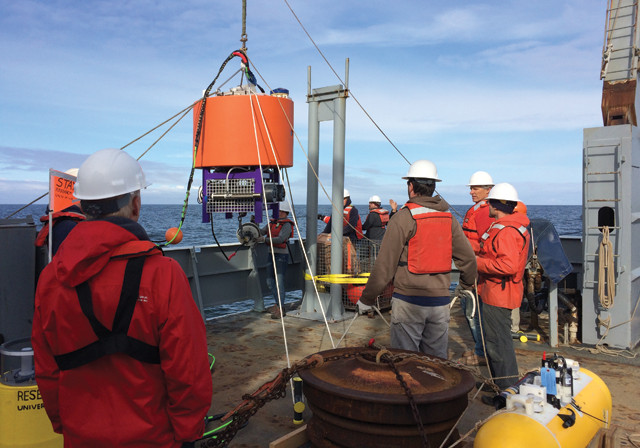
Researchers deploy an environmental sample processor off the coast of Washington on May 23, 2016, to analyze water samples for the presence of toxic algae species. Credit: Stephanie Moore.
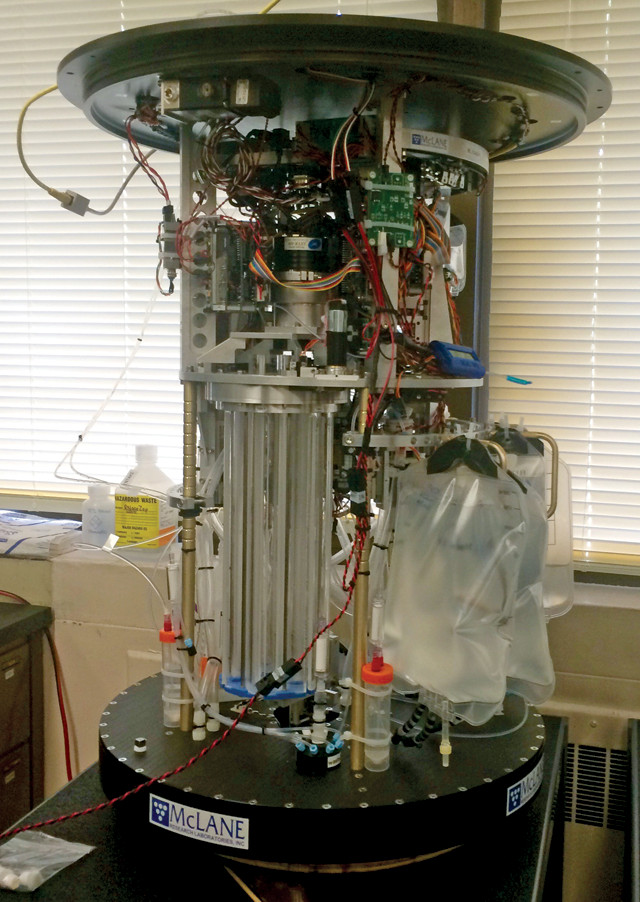
The interior of an environmental sample processor, which conducts tests on water samples at sea using self-contained instruments and reagents. Credit: NOAA.
Many phytoplankton species produce biotoxins at low levels under natural conditions. In addition to the diatom-produced domoic acid, certain dinoflagellate and cyanobacteria species can produce compounds such as saxitoxins, brevetoxins, anatoxins and microcystins — chemicals that can cause paralytic and neurotoxic poisoning when consumed or when people and animals are exposed to contaminated water. But scientists have a limited understanding of the physiological processes that sometimes lead algae to produce significantly elevated levels of toxins, Kudela says. The environmental factors that promote blooms are not necessarily the same as those that control biotoxin production.
Stress — caused by changes in temperature, light, or availability of nutrients and trace metals, for example — seems to be a likely driver of toxin production, but there are competing theories as to how this plays out. “It’s still a hypothesis, but scientists are gravitating toward the idea that toxicity is triggered by some environmental stress, such as limited nutrients,” McCabe says.
In a study published in PLOS One in 2016, researchers led by Xiuning Du of Oregon State University suggested that a late-winter phytoplankton bloom off the coast of Oregon in early 2015 may have helped draw down nutrients and enhance phytoplankton stress leading into the 2015 spring HAB. “If you get a nutrient-limited environment, [the Pseudo-nitzschia] may actually produce more domoic acid because it appears to help them take up any limited nutrients more readily,” McCabe says.
But laboratory experiments and coastal monitoring data have thus far complicated the picture: Both have suggested that a bloom becomes more toxic when it has access to more nutrients, not less. Whether nutrient additions are from “upwelling, river runoff or anthropogenic sources, we consistently see the toxicity increase up to about a factor of 10,” Kudela says. A possible explanation, he notes, is that upticks in toxicity with abundant nutrients may happen only after the algae were previously stressed in some way. In the case of the 2015 Pacific bloom, he says, it’s possible that warm, stratified waters may have initially stressed Pseudo-nitzschia cells and primed them to produce high levels of domoic acid early on; then, when the cells suddenly had access to nutrients via upwelling, the bloom and its toxicity took off.
While scientists continue to try to flesh out the primary drivers of algal toxicity, one thing remains clear: “It’s not random,” McCabe says. “It costs [the algae] energy to produce [these toxins], so there must be a good reason for it.”
For the most part, coastal states have been effective in protecting human health by quickly recognizing dangerous blooms and closing affected beaches and fisheries. The state programs responsible often consist of partnerships between fish and wildlife departments that routinely collect water and seafood samples at coastal sites, and state health agencies that conduct toxin analyses and set regulatory standards.
Through the National Centers for Coastal Ocean Science, NOAA supports several HAB-oriented research programs that work to establish and fund monitoring programs along the U.S. coasts; develop technologies and enhance natural defenses that could help prevent, control, or mitigate HABs; and fund research to understand the causes and impacts of HABs and their toxins. NOAA is also focused on establishing forecasting programs that operate much like weather forecasts, Trainer says. These forecasts will provide a synthesis of current environmental factors, including toxic algae type and abundance, together with ocean conditions and weather that might transport them to the coast. “The goal is to provide coastal managers with early warnings of impending blooms,” she says.
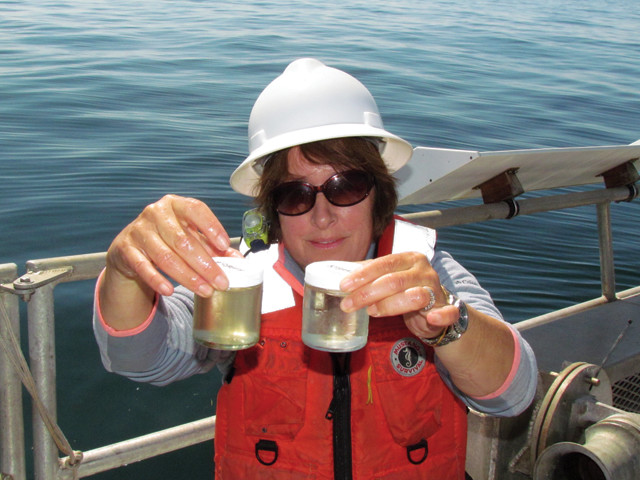
Vera Trainer, manager of the Marine Biotoxin Program at NOAA's Northwest Fisheries Science Center in Seattle, holds phytoplankton samples aboard the research vessel Tatoosh off the Washington coast. Credit: NOAA.
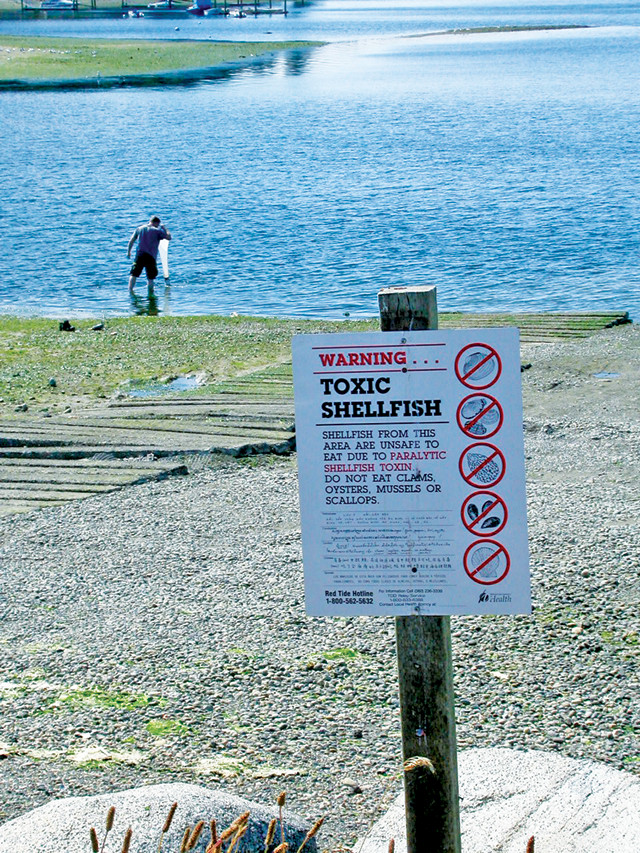
A sign warns of toxic shellfish at a beach in Puget Sound. Credit: NOAA.
There is also a growing system of onshore phytoplankton monitoring networks that link citizen groups with scientists. These volunteer groups sample water at beaches near where they live and are trained to use microscopes to identify potentially dangerous species in water samples. Programs like these, such as the Olympic Region HAB Partnership on the outer coast of Washington and SoundToxins in Puget Sound, Wash., provide managers with an early warning at sites where shellfish may soon become toxic.
“These are great programs,” Trainer says. “This information is powerful in that it allows people to know when they can have access to safe shellfish.”
The beach monitoring currently in place is essential to protect the public, McCabe says, but forecasting is far more difficult — and it’s made more challenging by a lack of consistent offshore monitoring. “To get any kind of heads up, you really need to know what is going on offshore, and particularly in the hot spots,” he says. NOAA conducts periodic offshore sampling on research cruises, but many bloom events arise and dissipate quickly, such that critical information about conditions leading up to, and during, the bloom is often missed.
“You can have all the latest, greatest numerical models for forecasting that you want, but if you don’t know that there are toxins or toxic species out there [offshore], then it won’t make much of a difference,” McCabe says. That’s why stable funding for offshore monitoring programs is needed, he adds. This is also where technology may help.
Robotic samplers called environmental sample processors are increasingly being used to monitor offshore waters. The instruments, attached to a mooring at sea or deployed from a ship, collect water samples and analyze them for a preprogrammed suite of algae species or toxins. The results are then transmitted back to scientists onshore who can relay necessary warnings to coastal managers and the public, Moore says.
A device called an Imaging FlowCytobot is another tool recently developed to monitor offshore waters. The instrument passes a water sample through a sensor, which photographs particles present in the water. Software compares the imaged particles to those in a library of known algae, allowing scientists to see all the species present in a sample. “There’s a species succession during a bloom,” Moore says. “The Imaging FlowCytobot can help us understand the competitive interactions between species.”
Even with these tools, offshore monitoring is still limited by the challenges of cost and deployment. In the meantime, researchers continue to develop models to help predict times and locations that might be favorable for HAB development and help provide early warnings that could trigger more targeted monitoring, McCabe says.
The increase in HAB frequency across the world’s oceans has provided scientists with more opportunities to study these complex phenomena. But even as scientific knowledge and tools grow, big questions remain, such as how the organisms and colonies involved are going to evolve.
“As these things show up in new places and under new conditions, they’re not necessarily going to behave in the same way,” Kudela says. “I don’t know if we can prepare for it, but we shouldn’t be surprised when it happens.”
© 2008-2021. All rights reserved. Any copying, redistribution or retransmission of any of the contents of this service without the expressed written permission of the American Geosciences Institute is expressly prohibited. Click here for all copyright requests.